QNAP TS-464 or the TS-453D NAS Drive – Which Should You Buy?
Are you considering the QNAP TS-464 now it has been released? Or thinking of saving some money and opting for the predecessor TS-453D that is currently on sale? It’s a tough decision for some that want to ensure value for money, yet remain future-proof. It is no secret that QNAP, much like many other NAS brands, refreshes their range of available hardware every few years. We are all quite used to tech makers producing a new version of their ‘thing’ that makes big and bold promises to be bigger, better and faster than what came before! In the case of Network Attached Storage though, one big contributing factor that often necessitates the release of new versions of their products and series is the CPU. CPU manufacturers such as Intel and AMD tend to perform refreshes of their own to their portfolios (retooling manufacturing plants for the newer processors and ceasing production of the previous chip) and this leads to NAS brands having to change their CPU in line with the chip manufacturers new revisions shortly afterwards. This new CPU revision will often open the door to further improvements in the rest of the hardware too and that is eventually what governs the shape and abilities of a new NAS release. This all too often though leads to a period of around a year when retailers that provide these solutions (everything from Amazon to specialized retailers) will feature both the older and newer NAS systems in stock at the same time and that leads to many, MANY buyers wondering whether it is worth saving some money and purchasing the previous NAS release on ‘sale’ or spending more and getting the newest release to be more future-proof. Given that both the TS-464 and TS-453D run IDENTICAL versions of the QNAP QTS 5 system software and services, the temptation to save a few quid and/or spend that saving on network improvements or more storage is pretty high. Also, the TS-453D released back in 2020 arrived on the market at $630 and is now available to buy for $549 (or even as low as $438 during seasonal sales such as Prime Day and Black Friday), see below:
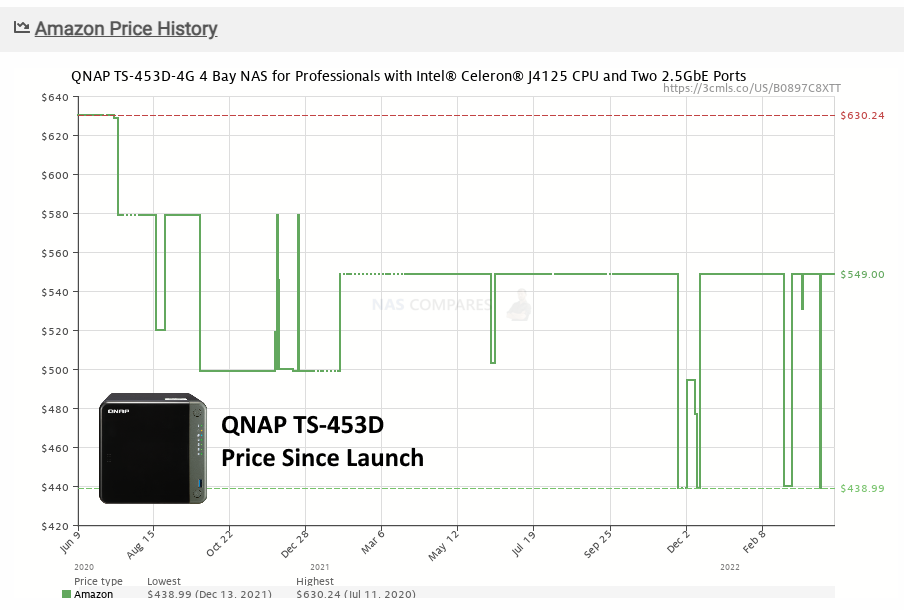
Now, if you compare that against the newly released QNAP TS-664, which has seemed to hit the eShops at around $600-650, that is quite a big difference in price tag. So, today I want to compare the QNAP TS-464 released now in spring 2022 against the 2020 released TS-453D, just to see where that extra goes. On the face of it, we have two very, VERY similar NAS drives that simply arrive in different colours but have all the same ports. However, even the smallest dig into their respective specifications reveals a huge difference in the bandwidth and capacity in how these ports have changed. Let’s begin
QNAP TS-464 or the TS-453D NAS – Design
The design of the TS-464 and TS-453D are INCREDIBLY similar. The chassis that both NAS systems use a black, plastic and matt textured enclosure, with a coloured front side panel and a removable glass effect front cover that reveals the main SATA bays. This external plastic casing covers the internal metal structure completely and passive airflow via ventilation is quite discreet around the box, facilitated by a larger single 120mm rear fan on both NAS. This design has been their main choice for their flagship series since the release of the TS-x53B and TS-53Be devices in 2017/2018 and is quite understated. Of the two I SLIGHTLY prefer the copper effect side panel of the TS-464 over the TS-453D, but this is a purely personal preference.
| QNAP TS-464 NAS
168mm × 170mm × 226 mm |
QNAP TS-453D NAS
168mm × 170mm × 226 mm |
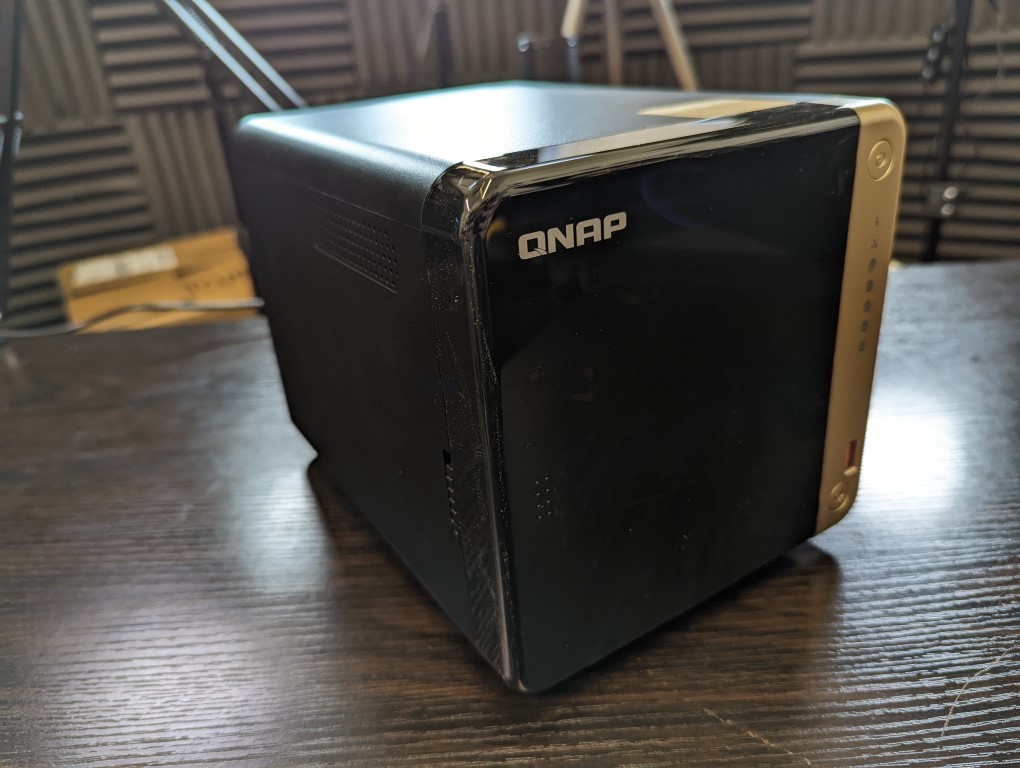 |
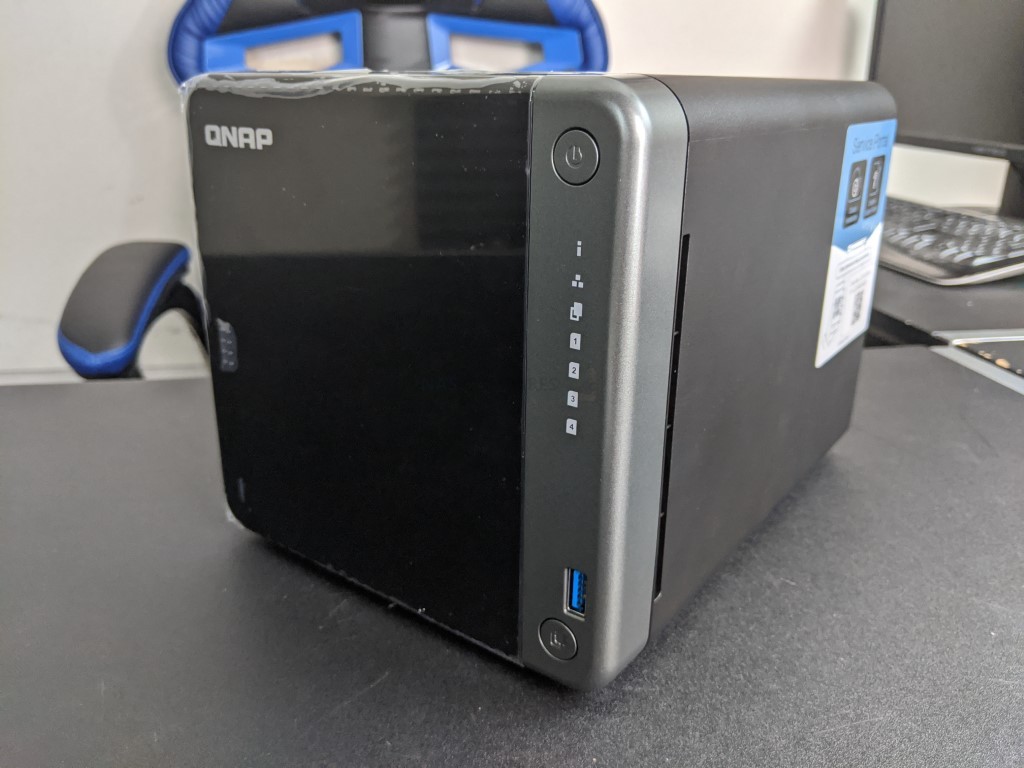 |
Ventilation and notice on both the QNAP TS-464 and TS-453D are largely identical, however, there is the tiniest potential increase possibility in fan operation in the TS-464, due to the increased hardware inside the enclosure that I will touch on and the system needing to maintain an efficient system temperature. However, ventilation on both of these NAS systems is a limit more understated than alternatives from the likes of Synology, as the side vents on both these NAS are quite small (with a larger base vent panel under the SATA media bays) and I have always wondered how much impact the lockable front panel of this chassis design impacts airflow from that rear active cooling fan (negatively, positively or no different). But nevertheless, the chassis has little or no difference in the two years between the TS-453D and TS-464 being released.
| QNAP TS-464 NAS | QNAP TS-453D NAS |
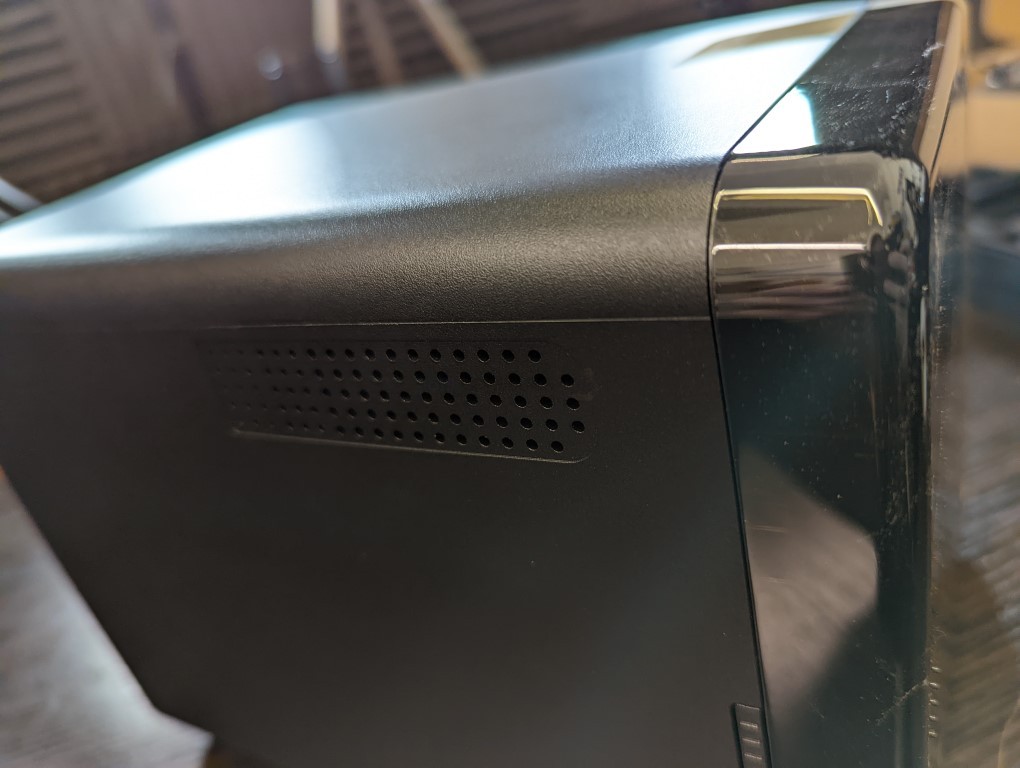 |
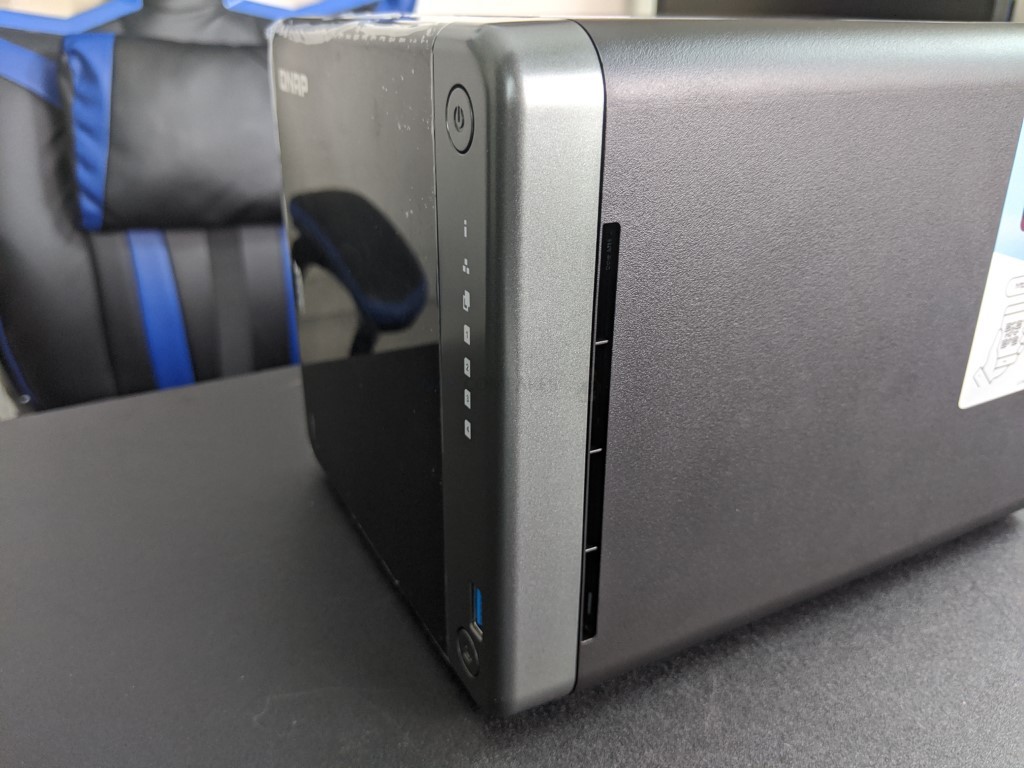 |
The rear of each of these NAS systems are largely the same, however, the rearrangement of the ports of the newer TS-464 (likely to make room for additional internal M.2 NVMe SSD slots that we will discuss later) has led to them being a little between distributed across the internal board. The vents in the metal rear panel of the older TS-453D are wider than those found on the TS-464, though I am not entirely sure of the reasoning behind this decision (dust control, creating increased velocity for the air via compressed channels? I have no idea), but it does not seem to affect system temperature either way when we checked the system diagnostics after 24 hours power-on. The fan is completely automated to increase/decrease as the system temperature monitor dictates but can be adjusted higher or lower in RPM manually if needed for reasons of preemptive high system activity or noise adjustment. Personally, I would ALWAYS leave this on automatic.
| QNAP TS-464 NAS | QNAP TS-453D NAS |
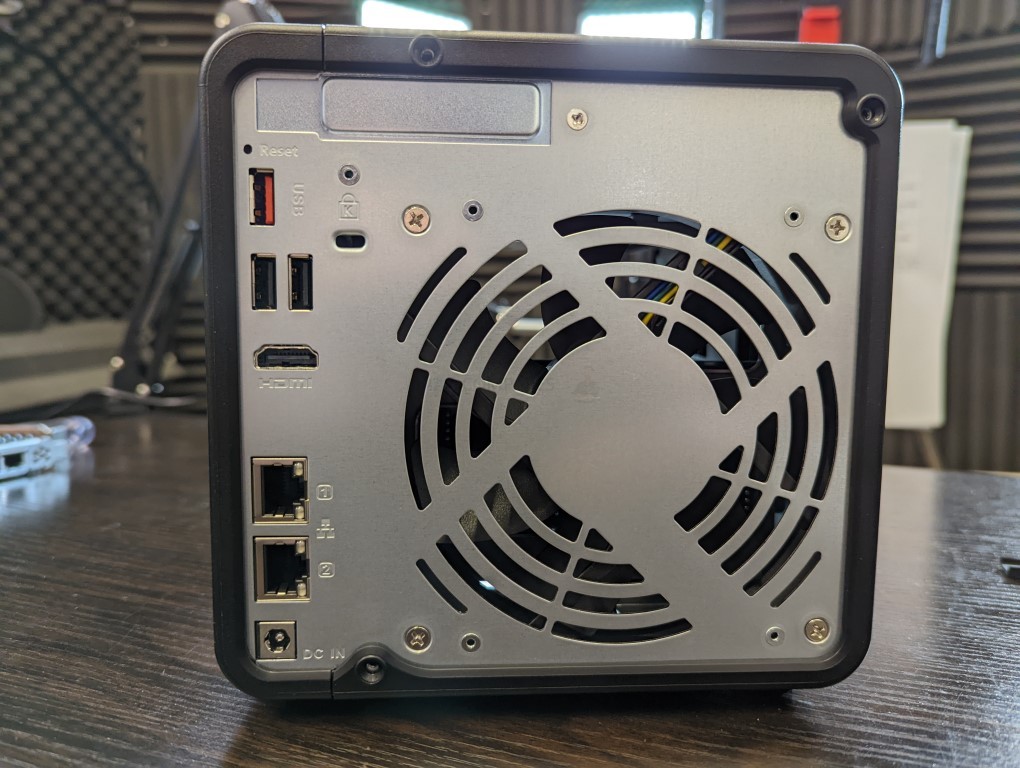 |
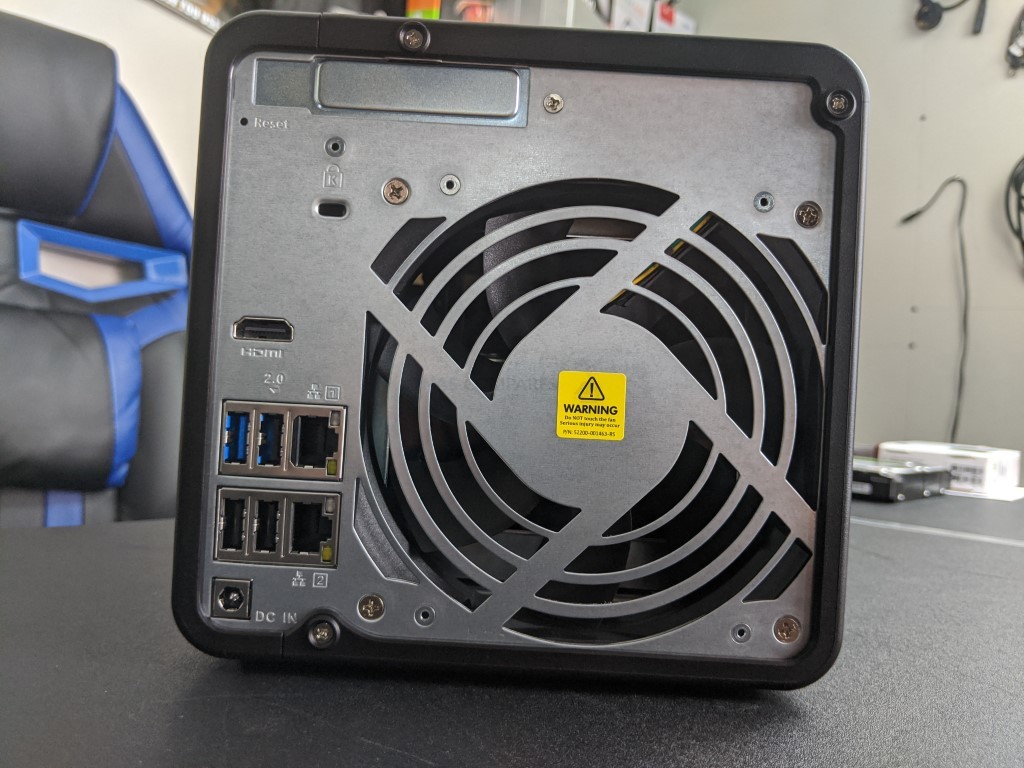 |
Overall, the design of the QNAP TS-464 and TS-453D has changed so very little, that there is little or no difference between them of note. Both are particularly compact 4 bays that can be deployed pretty easily. Let’s dig down into the internal hardware of these two NAS, as it is there that we really really start to see how much has changed in two years and gives us a clearer picture of which one will be better value for money.
QNAP TS-464 or the TS-453D NAS – Internal Hardware
Right, so HERE is where we start to see some big differences between the TS-464 and TS-453D, as QNAP are able to take advantage of a better CPU to spread their hardware and bandwidth a great deal more. Once again though, on the face of it, the specifications are incredibly similar. Both use quad-core Intel Celerons, both arriving at 2.0Ghz with embedded graphics and both using 4GB DDR4 memory, yet more than a $/£/€100-150 difference! This is down to the maximum capacities afforded to this hardware in the TS-464 and its scalability down the line. For example, the default memory inside the TS-453D (ADATA 2400Mhz DDR4 non-ECC SODIMM) is also accompanied by an additional empty memory slot to allow an additional 4GB more memory. As the older TS-453D has a CPU that has a maximum 8GB of memory, this is perfectly fine. However, the TS-464 NAS’ newer gen CPU allows up to 16GB of memory (4GB of 2666Mhz memory in the default model) across two upgradable slots. Likewise, the newer system features those M.2 NVMe slots that can be used for SSD storage upgrades. Although both the TS-453D and TS-464 support SSD caching (when a pool of SSDs is used to speed up data write/read in conjunction with the larger HDD RAID array), Qtier and as standalone storage pools, the TS-464 is the only one that provides this as immediately without any upgrade cards. This is the first of several key differences between the QNAP TS-464 and TS-453D NAS that stem from the CPU choice. Here is how they scale up specifically though:
| Model | TS-464
|
TS-453D
|
| Price | £559 $650 €675 | £429 $530 €549 |
| Storage Media Support | 4x SATA, 2x m.2 NVMe 3×1 | 4x SATA |
| CPU Model | Intel N5105/N5095 | Intel J4125 |
| CPU Frequency & Cores | Quad-Core 2.0-2.9Ghz | Quad-Core 2.0-2.7Ghz |
| CPU Benchmark Score | CPU benchmark 4161 | CPU benchmark 3006 |
| Memory Default/Max | 4-16GB SODIMM DDR4 | 4-8GB SODIMM DDR4 |
| PSU Power & Design | 90W External PSU | 90W External PSU |
| Physical Fans | 1x 120m FAN | 1x 120m FAN |
Now, that CPU is the big game-changer here. When Intel made the switch to the newer N5105/N5095 processor, this opened the door to a bunch more ways to extend the efficiency and bandwidth of those existing physical services. NAS systems are designed to be operational for days, weeks, months and even years at a time. Therefore, in order to maintain optimal performance, as well as lower power consumption and lessen the damage that long term operation can inflict on a processor, the CPUs used in NAS are a great deal more modest. In the case of the TS-453D and TS-464 NAS, they feature Intel Celeron processors, each featuring an embedded graphics component (allowing graphical operations, multimedia handling and visual data to be handled by a specialized area of the processor), quad-core architecture and a base level clock speed of 2.0Ghz that can be burst (turbo/increased when needed). However, the newer generation N5105/N5095 CPU in the TS-464 is able to reach a higher overall clock speed and also is more efficient (i.e uses a little less hardware resources to get a task done than it would take on the J4125 typically, so, therefore, can do more tasks overall when the full CPU power is utilized). Indeed, CPUBenchmark rated the newer CPU 30%+ higher in its scoring than the J4125 (again, as you would expect for a CPU released more than a year later by Intel), so this processor means that more can be done on the TS-464 (in like for like tasks) and also this CPU allows a greater range of hardware to be built into the system. CPUs are one of the largest quantifying factors of how a NAS is built and this is because they can only handle a certain amount of connected hardware (storage bays, ports, expansion slots, etc) when connected to a larger controller/motherboard. This is commonly referred to as the # of PCI lanes and the chipset used in the build of the system. Because this newer Intel N5105 / N5095 CPU has more lanes to use at once than the J4125, it allows the newer NAS drive to have more hardware.
|
QNAP TS-464 NAS – Intel N5105/N5095 CPU
|
QNAP TS-453D NAS – Intel J4125 CPU
|
These additional CPU resources, as well as the increased maximum memory and flexibility the TS-464 providing M.2 NVMe SSD slots can be used ultimately means that in terms of internal hardware, the newer released QNAP TS-464 wins over the TS-453D NAS. It is worth remembering that the M.2 NVMe SSD slots on the QNAP TS-464 are PCIe Gen 3 x1 (down to the Celeron CPU still not having anywhere near the scope in its flexibility that the likes of an Intel Core, Ryzen or Xeon might have) and will bottleneck at 1,000MB/s, but this is still better than nothing and as these slots are not an option on the TS-453D without the installation of an M.2 NVMe SSD upgrade card over PCIe.
QNAP TS-464 or the TS-453D NAS – Ports & Connections
Once again, the ports and connections available on the QNAP TS-453D and TS-464 seem near enough identical at a glance, but even a casual dig into those spec sheets real some big differences. Both systems provide two 2.5GbE network ports that, along with up to 260-270MB/s throughput, also allow port-trunking (otherwise known as link aggregation) and with the use of a smart switch can provide 500-550MB/s performance to your connected network. Alongside this, both systems support the QNAP USB 3.2 to 5GbE adapter to add further network ports to the system too. Likewise, both system provide an HDMI 2.0 4K 60FPS port and USB 2.0 ports for a KVM (keyboard, video, Mouse) setup to be used in conjunction with the included parallel HD Station application and its tools. The HDMI and direct interface of the QNAP is still pretty niche as a service on this system, but it has a number of useful multimedia, surveillance and VM utilities that can be quite impressive. Finally, Expansions on the TS-464 and TS-453D are largely the same, with QNAP offering 2, 4, 6, 8 and 12-Bay expansion chassis (arriving in JBOD or hardware RAID enabled) that connect over USB or an inclusive PCIe card. However, after this, things become a great deal more future proof and scalable on the TS-464 NAS.
| Model | TS-464
|
TS-453D
|
| Network Ports | 2x 2.5GbE | 2x 2.5GbE |
| USB 3.2 Ports | 2x USB 3.2 Gen 2 (10Gb) | 2x USB 3.2 Gen 1 (5Gb) |
| USB 2.0 Ports | 2x USB 2.0 | 3x USB 2.0 |
| HDMI Ports | 1x HDMI 2.0 4K 60FPS | 1x HDMI 2.0 4K 60FPS |
| PCIe Upgrade Slots | PCIe Gen 3×2 Slot (2Gb/s) | PCIe Gen 2×2 Slot (1Gb/s) |
The first difference worth highlighting is regarding those USB ports. The older TS-453D features USB 3.2 Gen 1 (AKA USB 3.0 or USB 3.1 Gen 1) ports that provide up to 5Gb/s (500MB/s+) bandwidth with connected external storage media (i.e you would need a RAID enabled HDD USB enclosure or SSD drive in order to hit this performance cap). The TS-464 on the other hand features USB 3.2 Gen 2 (AKA USB 3.1 Gen 2 – THANKS for the name nonsense ‘USB.org’!) which can provide 10Gb/s performance (i.e 1,000MB/s). As SSDs become increasingly affordable and even external m.2 NVMe SSD enclosures arriving at a bargain, this option to have a significantly faster backup drive option available is quite attractive. Especially for those that plan on having a USB tier to their multi-stage NAS Backup strategy and choose to have dated/versioned backups, rather than differential backups just ‘topping things up’ over time. Another big difference of note is in that PCIe upgrade slot. Both the TS-453D and TS-464 feature the option to install a PCIe upgrade card that can include options to add better network interfaces (2.5/5/10G or WiFi 6 / AX wireless options) with multi-port card, storage upgrade cards (adding multiple M.2 NVMe and SATA bays) or even combo cards that feature both on a single card. The difference between the TS-464 and TS-453D though stems from the bandwidth afforded these slots, with the TS-453D arriving with a PCIe Gen 2×2 slot and the TS-464 having a PCIe Gen 3 x2 slot. This results in the newer NAS providing DOUBLE the potential bandwidth of the TS-453D when installing an upgrade card. So this will be particularly useful when installing multiport network upgrade cards and SSD cards that exceed 1,000MB/s, as well as combo cards that need to spread the bandwidth a bit. Overall, the hardware in the TS-464 is certainly better and broader than the TS-453D, but it is worth remembering that the bulk of these advantages and improvements made in the 2 years later hardware release can be viewed in terms of optional scalability and expandability – so you are going to need more hardware to take advantage and almost certainly not advantages that most users will take advantage of on day 1.
QNAP TS-464 or the TS-453D NAS – Software
This is pretty much the smallest difference that can be measured between the QNAP TS-464 and QNAP TS-453D NAS. Both these NAS systems run the QTS 5 operating system, services and applications available for the platform and numerous client hardware devices (Windows, Mac, iOS, Android, Linux, etc). The only REAL difference between these two NAS systems is the fact that the improved hardware inside the newer TS-464 (more efficient and higher clock speed CPU, after memory and large maximum RAM threshold) allows a larger number of actions and clients to be managed at a single time than the TS-453D NAS. However, in smaller or single operations, you are not going to feel/see the difference, unless you are particularly pushing the CPU or Memory utilization in a single client interaction (i.e surveillance camera feeds, Virtual Machine deployment, transcoding natively and/or Plex, etc). Likewise, the inclusion of the default M.2 NVMe slots on the TS-464 means that you have a few extra SSDD services available on day 1, but these are still available to the TS-453D via either the installation of a PCIe upgrade card OR using SATA SSDs internally. Below is a breakdown of the applications and services that are included in QTS available on both NAS systems.
| TS-464
|
TS-453D
|
|
| Browser Support | Supports all Browsers | Supports all Browsers |
| Browser File Management | Browser File Management | |
| Photo/Music/Video Tools | Photo/Music/Video Tools | |
| Multimedia Console | Multimedia Console | |
| AI Photo Recognition | AI Photo Recognition | |
| Edge m.2 Coral TPU Support | ||
| Storage Services | ||
| SED Drive Support | SED Drive Support | |
| QTier | QTier | |
| Hybrid Mount | Hybrid Mount | |
| ISCSI Target/LUN | ISCSI Target/LUN | |
| vJBOD | vJBOD | |
| Snapshots | Snapshots | |
| SSD Cache (Read/Write/Both) | SSD Cache (Read/Write/Both) | |
| Cloud Sync / QSync | Cloud Sync / QSync | |
| Ex-FAT is Free | Ex-FAT is Free | |
| RAID Resync control | RAID Resync control | |
| Secure Erase | Secure Erase | |
| Lots of Expansions (TR/TL) | Lots of Expansions (TR/TL) | |
| HBS 3 | HBS 3 | |
| Qfiling and Qsirch | Qfiling and Qsirch | |
| Business Applications | ||
| QVR Pro – 8 Camera Licenses | QVR Pro – 8 Camera Licenses | |
| Virtualization Station | Virtualization Station | |
| Ubuntu Linux Station 18/20 | Ubuntu Linux Station 18/20 | |
| Container Station | Container Station | |
| Hypervisor Protector | Hypervisor Protector | |
| QMailAgent | QMailAgent | |
| HD Station | HD Station | |
| BoXafe | BoXafe | |
| Security | ||
| Security Councillor | Security Councillor | |
| Malware Remover | Malware Remover | |
| McAfee Anti-Virus Scanning | McAfee Anti-Virus Scanning | |
| QVPN | QVPN | |
| Log and Notification Center | Log and Notification Center | |
| Auto Blocking on SSH, Telnet etc | Auto Blocking on SSH, Telnet etc | |
| 256 bit Encryption | 256 bit Encryption | |
| 2 Step Authentication | 2 Step Authentication | |
| Firewall App | Firewall App | |
| Access Protection and Allow/Deny list | Access Protection and Allow/Deny list |
Although you are going to be able to do more of these things above simultaneously on the TS-464 than the TS-453D NAS, it is not a huge win for the newer box and once again, this win comes largely down to futureproofing than anything you will feel on Day 1. You can learn more about the QNAP QTS Platform in my review below in both video and blog form:
| QNAP QTS 5 Review Video | QNAP QTS 5 Review on the Blog |
 |
QNAP TS-464 or the TS-453D NAS – Conclusion
It will come as no shock that the newer QNAP TS-464 NAS is the better choice in the long run compared with the QNAP TS-453D, thanks largely down to a larger degree of upgrades, storage scaling in the future and resource expandability. If you KNOW you are not going to be scaling up your storage hardware in the next 4-5 years, then perhaps the TS0453D is a better choice for you, using that saved $/£/€100-150 difference towards more storage, network interface upgrades or improving your in-house network environment generally with 2.5GbE or 10GbE. The software provided on both systems is still very good value for money and QNAP is still one of the few brands that provide this level of hardware (plus inclusive software and services) at this price point. Equally, you are almost certainly going to see the QNAP TS-453D at ever more attractive price points at retailers and it is still a great little NAS (check out my 2020 review of the TS-453D HERE). But you simply cannot ignore the number of ways that the base level TS-464 NAS can be upgraded and improved in its lifespan and for those that want a ‘blank canvas’ NAS solution that they can then change alongside their own network client hardware in the home/office, the TS-464 NAS is the more mature and long-term choice easily.
|
QNAP TS-464 NAS – Spring/Summer 2022
|
QNAP TS-453D NAS – Spring/Summer 2020
|
||
|
Reasons to Buy it? Better Hardware inside and out More Expansion/Upgrade Options Able to run more simultaneous apps/clients at once Faster USB Ports (10Gb/s) Larger bandwidth PCIe upgrade slot (PCIe 3×2 vs 2×2) Higher CPU Frequency, Efficiency & Proficiency |
Reasons to Buy it? Lower Current Price Point Overall lower power consumption Better ventilation internally and on fan panel design More USB Ports overall More likely on Sale over Black Friday/Seasonal Sales |
||
| Buy on Amazon | Where to Buy |
Buy on Amazon |
Where to Buy |
🔒 Join Inner Circle
Get an alert every time something gets added to this specific article!
This description contains links to Amazon. These links will take you to some of the products mentioned in today's content. As an Amazon Associate, I earn from qualifying purchases. Visit the NASCompares Deal Finder to find the best place to buy this device in your region, based on Service, Support and Reputation - Just Search for your NAS Drive in the Box Below
Need Advice on Data Storage from an Expert?
Finally, for free advice about your setup, just leave a message in the comments below here at NASCompares.com and we will get back to you. Need Help?
Where possible (and where appropriate) please provide as much information about your requirements, as then I can arrange the best answer and solution to your needs. Do not worry about your e-mail address being required, it will NOT be used in a mailing list and will NOT be used in any way other than to respond to your enquiry.
Need Help?
Where possible (and where appropriate) please provide as much information about your requirements, as then I can arrange the best answer and solution to your needs. Do not worry about your e-mail address being required, it will NOT be used in a mailing list and will NOT be used in any way other than to respond to your enquiry.

|
 |
How Much RAM Do You Need in Your NAS?
A Buyer's Guide to Travel Routers - GET IT RIGHT, FIRST TIME
Jonsbo N6 DIY NAS Case Review
The Best Bits (and Worst Bits) of NAS of 2025!
Minisforum MS-02 Ultra Review
Minisforum N5 NAS, 6 Months Later - Better, Worse, the Same?
Access content via Patreon or KO-FI
Discover more from NAS Compares
Subscribe to get the latest posts sent to your email.


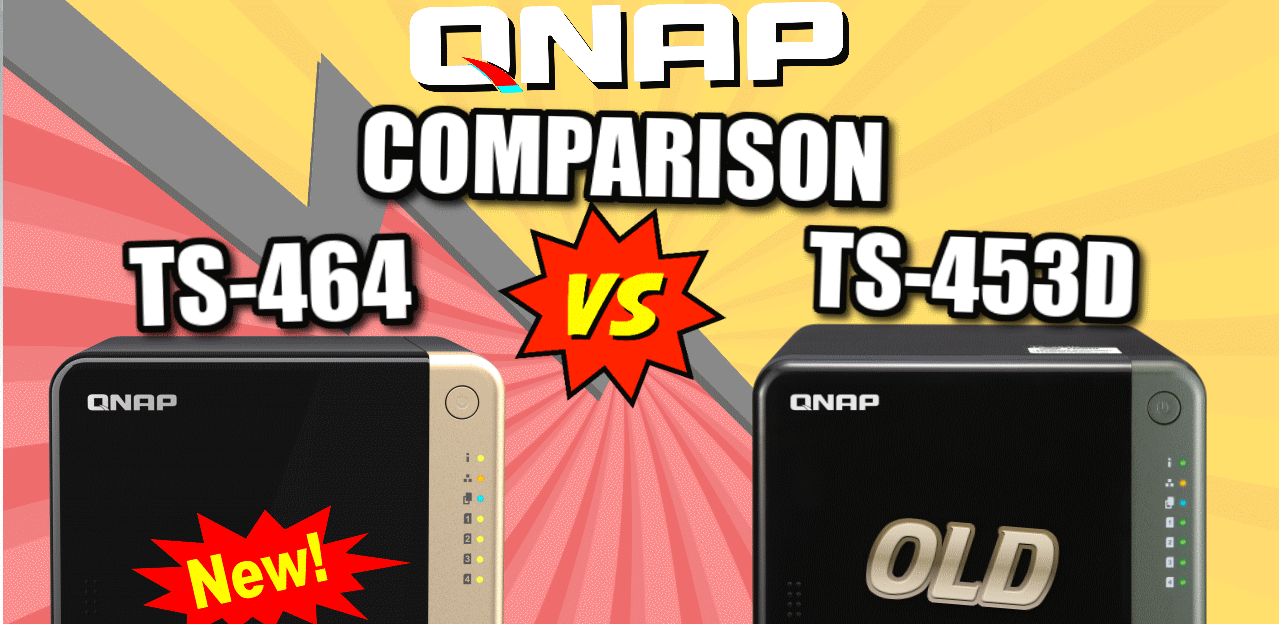
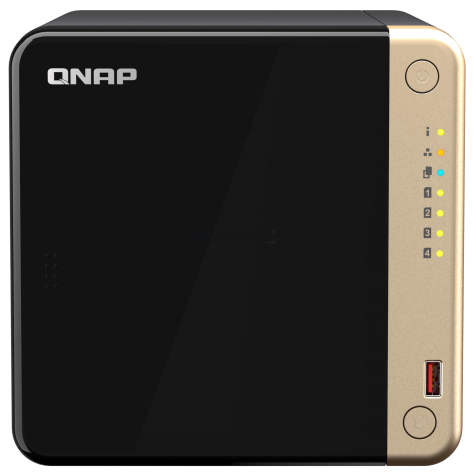
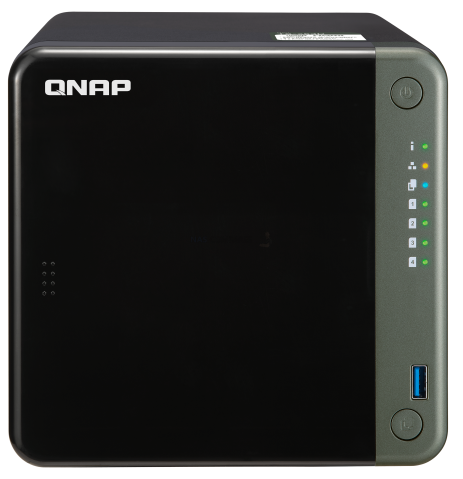

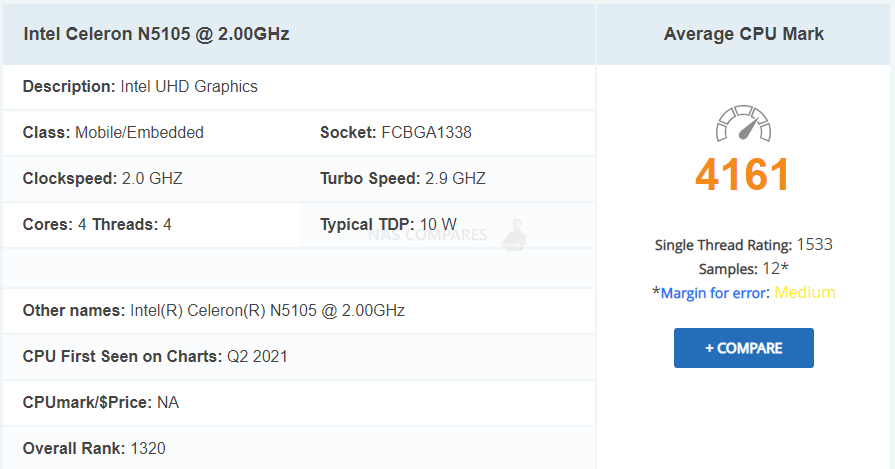
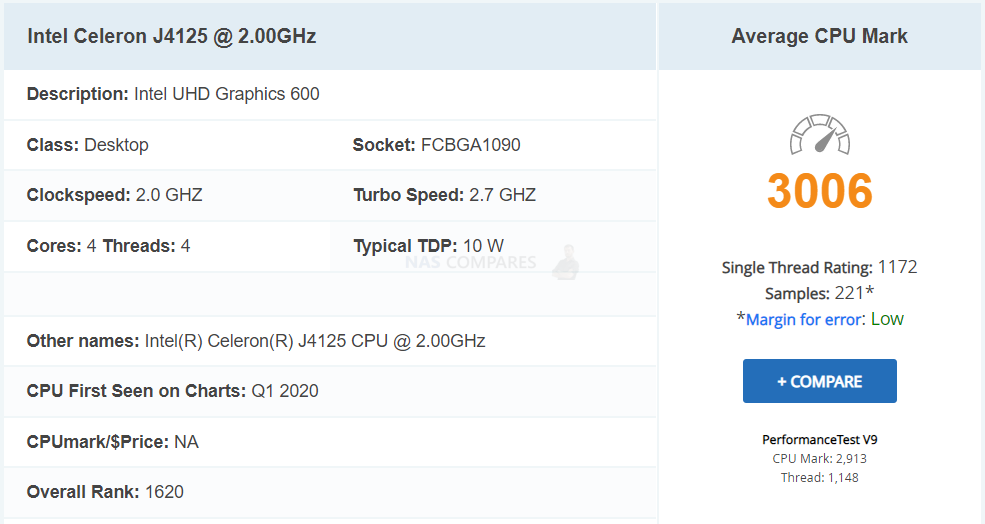
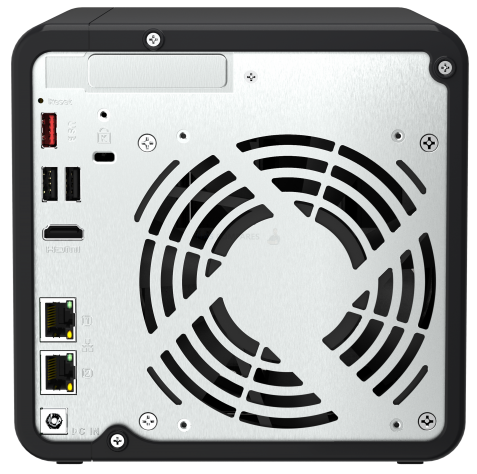
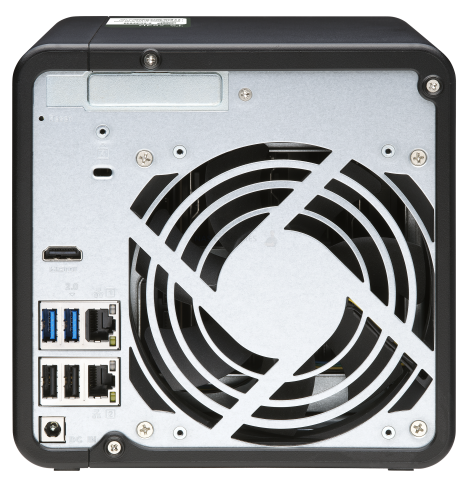




This video must have taken a long time to record and edit. Thanks, it helped me lot.
REPLY ON YOUTUBE
Qnap licensing are going to be their killer. They should at least make it free for home use.
REPLY ON YOUTUBE
that there on the left a long boi
REPLY ON YOUTUBE
QNAP TS-464-8G VS TS-453D 4G . still win the 453D with 4G? THANKS
REPLY ON YOUTUBE
Looks as if Synology is getting its as kicked.
REPLY ON YOUTUBE
Can the TS-435D play H.265?
REPLY ON YOUTUBE
Thank you man, great reviews!
REPLY ON YOUTUBE
Thanks
REPLY ON YOUTUBE
The 453D runs fine with more than 8 Gigabytes of memory. Im running with twelve (8+4) with no issues!
REPLY ON YOUTUBE
Is the 464 actually available in “the west”?
I gave up and vot the 453d and i’m happy with it. Too much fomo ptsd from the graphics cards to “wait for the better one” that eventually gets delayed or worse
REPLY ON YOUTUBE
So what would be preferable for a first-time user? Qnap or Synology?
REPLY ON YOUTUBE
I’m continually amazed by how much bang-for-buck you get with QNAP. I mean hardware-wise they simply leave the competition in the dust. If they up their software to include some sort of SHR equivalent, the choice to leave Synology behind would be a no-brainer IMHO.
REPLY ON YOUTUBE
Looks like it would be a good upgrade if we could source any qnap units here in ‘Srayamate.
REPLY ON YOUTUBE
Great breakdown!
REPLY ON YOUTUBE
If anyone got hung up on the eight gigabyte ram limit on the older model, I have the six bay, and I’ve been running the 16 gigabytes of ram that I had in a Gigabyte Aero 15s for a long time. I had no issues with it.
REPLY ON YOUTUBE
Too late.
REPLY ON YOUTUBE
What about stability between the two?
REPLY ON YOUTUBE
Thanks for all your great videos – I am looking to upgrade my NAS and have settled on a Qnap TS-673A it will be my “home” NAS should I use QTS Hero ZFS or QTS 5 as my OP? Which is best? One of the main things I want to use is MyCloudLink (which I presume I can use on both OP)
REPLY ON YOUTUBE
As a new user you really make what was looking like a dive into the matrix, into something that I can actually folow. Thank you
REPLY ON YOUTUBE
Dose qnap have some sort of hybrid raid ? That back up and save space.
REPLY ON YOUTUBE
Latest QTS 5 firmware update lost every user’s “home” folder when connecting via AFP in a finder window, only shared folders are shown. Even disabling and enabling home folders in users don’t take any effect. Only In browser UI the home folder is working properly.
REPLY ON YOUTUBE
I have TS253be and update to QTS 5.0 but NAS force me to initialize NAS (Reset NAS set up)
My raid was gone (Raid 1) while I Initialized NAS to start 5.0 and I try to back up my data to external hdd
but my 2nd disk was gone while back up I can recovery data 70% (Lost forever 30%) T.T
Do you have problem to upgrade like me?
REPLY ON YOUTUBE
Do you have an ETA for full release QuTS Hero 5.0?
REPLY ON YOUTUBE
I had to roll back.
5.0.0. gave me two weird issues.
1. The fans went to 100% and stuck there, regardless of any setting or actual system temp.
2. (And this one is really weird) IR remote button pushes would be registered twice, but only around 25-33% of the time.
I rolled back AND forward three times to check and double check these issues. I’m staying with 4.5.x until I know 5.x.x has the bugs ironed out.
REPLY ON YOUTUBE
i have found the file permission are better but….. in my case the everyone group has no rights assigned to it when checking on qnap.not denied not ro or rw. when you create a user via qnap and assign rights via windows. somewhere along the line everyone has now changed to denied access…..simply just remove anyone from the resource…but not the right way?
REPLY ON YOUTUBE
FULL Written Review of QNAP QTS 5 – https://nascompares.com/2021/10/08/qnap-qts-5-0-nas-software-review-worth-your-data/
01:50 – Disclaimers & Review Considerations
05:25 – Start – QTS Change of Focus
07:00 – QTS 5 vs QTS 4.5 GUI, Design, The Good, the Bad & the Awkward
10:13 – Responsiveness
10:44 – Things That Have Not Changed
11:30 – Security, Notifications & Control
14:25 – Control Panel
15:39 – Storage Manager
17:25 – Remote Mounting & Cloud Gateways
18:40 – File Management
20:30 – Multimedia Control & Sharing
27:00 – Storage Continued – Health & Checks
29:00 – Synchronization & Backup Tools
36:35 – Virtual Machines, Containers & Ubuntu VMs
41:05 – VMware, Hyper-V and SaaS Backups
43:14 – HDMI Services & HD Station
45:00 – Surveillance Tools & Services
49:00 – Licenses, Good & Bad
51:00 – QSirch, QFile, Teamviewer, Hybrid Mount and the Conclusion
REPLY ON YOUTUBE
Add chapters to this video
REPLY ON YOUTUBE
I have a TVS 873e when i seach for the upgrade to QTS 5 on the QNAP site it is not showing it for me. the highest firmware is 4,5,4 1800 am i not able to run V5?
REPLY ON YOUTUBE
Why the full release of QTS 5.0 is not arrived yet on TS-X53D series ?
REPLY ON YOUTUBE
awesome, perfect video as always; you’re the best source for nas – especially on qnap, i would say. Possessor of the – NOWADAYS pretty old – ts231+P and i still use it as my daily driver; with the new qts 5 now, seems even more faster
REPLY ON YOUTUBE
That robot reminds me of the old MS office “clippy”… Luckily he doesn’t ask “it appears you are trying to…” ????
REPLY ON YOUTUBE
That robot in the corner…. Reminds me of clippy… kill it with fire!
REPLY ON YOUTUBE
How did you get this installed on a TVS-872X? I am trying to get it on my TVS-872XT and this model is not officially supported on this initial 5.0 release.
REPLY ON YOUTUBE
First! Always love the content!
REPLY ON YOUTUBE